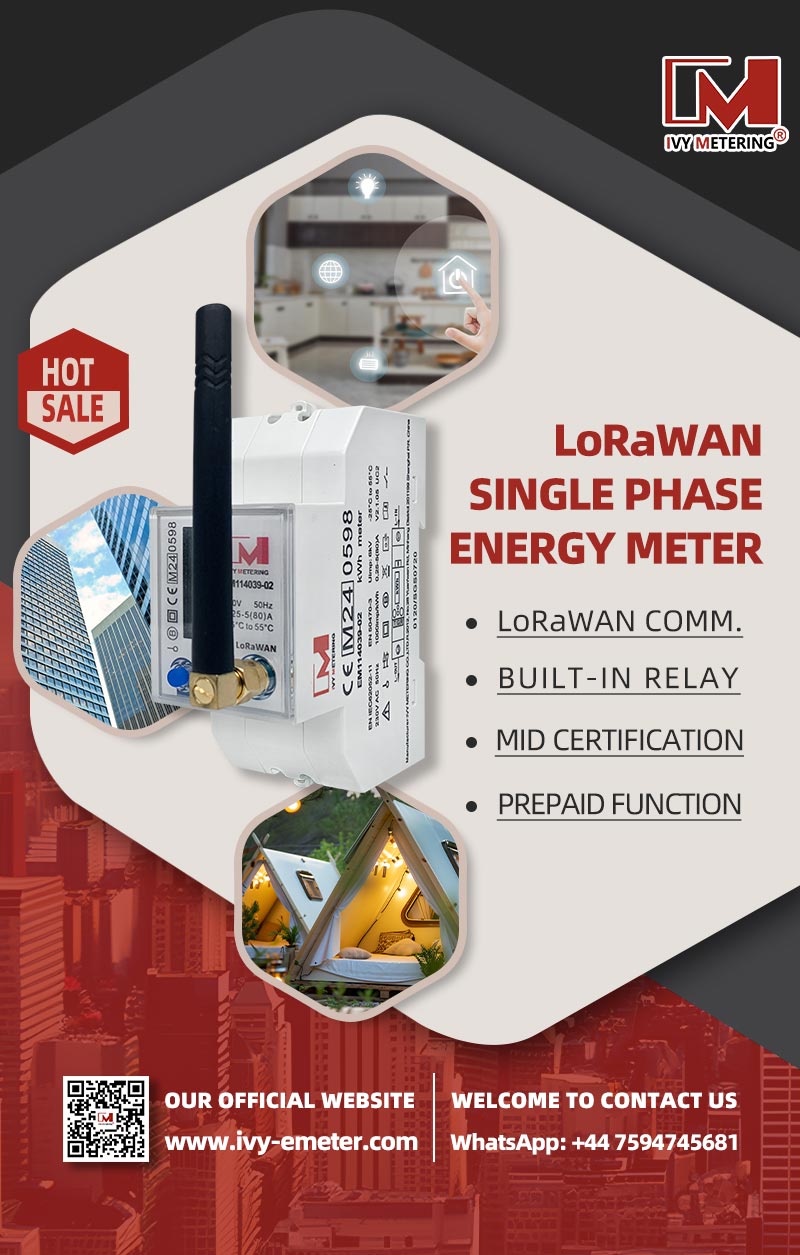
EM114039-02 is a single-phase LoRaWAN prepaid energy meter, the meter has a built-in relay, supports the prepaid function, can remotely control and read data through LoRaWAN communication, and the meter has passed the MID certification. This LoRaWAN prepaid smart kWh meters provide a valuable tool for smart building management, enabling enhanced energy efficiency, cost savings, improved sustainability, and a better overall experience for building occupants.
1.Technical Parameters
Product Type | Single Phase LoRaWAN Electricity Meter |
Ref. voltage | 220V |
Ref. current | 0.25-5(80)A |
Impulse Constant | 1000imp/kWh |
LCD Display | LCD5+1 |
Operation Temp. | -20~+70℃ |
Relative Humidity | <95% |
Ref. frequency | 50Hz |
Accuracy Class | Cl.1 |
Starting Current | 0.4%/Ib(CI.1) |
Load Control | Built-in 80A magnetic latching relay |
Power Consumption | ≤ 1W,<10VA |
Standard Compliant | IEC62052-11/IEC62053-21, |
LoRaWAN Communication | EU868MHz |
LoRaWAN Antenna | SMA Socket |
Mode | Prepaid Mode(Energy) Prepaid Mode(Credit) Postpaid Mode |
2.Key Features

3.Why choose Lorawan energy meter for smart building, what's the benefits?
1. Enhanced Energy Management:
Real-time Monitoring: LoRaWAN enables real-time energy consumption data collection from various points within the building. This granular data provides insights into energy usage patterns, identifying areas of high consumption and potential inefficiencies.
Demand-Side Management: Prepaid meters encourage more conscious energy consumption. Users can actively monitor their energy usage and adjust their behavior accordingly, such as reducing peak-hour usage to lower costs.
Load Balancing: By analyzing real-time consumption data, building managers can optimize energy distribution, preventing overloading and potential power outages.
2. Cost Savings:
Reduced Energy Costs: By identifying and addressing energy inefficiencies, smart buildings can significantly reduce their overall energy consumption and associated costs.
Prepaid Model Efficiency: Prepaid systems can streamline billing processes and potentially reduce administrative costs.
Improved Budget Control: Prepaid meters provide better control over energy expenses, allowing building owners and managers to budget more effectively.
3. Improved Sustainability:
Reduced Carbon Footprint: By optimizing energy usage, smart buildings with LoRaWAN meters contribute to a reduced carbon footprint and a more sustainable environment.
Renewable Energy Integration: LoRaWAN can facilitate the integration of renewable energy sources, such as solar panels, into the building's energy grid.
4. Enhanced Tenant Experience:
Increased Transparency: Prepaid meters provide tenants with greater transparency regarding their energy consumption and costs.
Greater Control: Tenants can actively manage their energy usage and costs, leading to increased satisfaction and comfort.
5. Improved Safety and Security:
Early Detection of Issues: Real-time data monitoring can help identify potential electrical problems, such as overloads or short circuits, early on, preventing potential safety hazards.
6. LoRaWAN's Advantages:
Long Range: LoRaWAN's long-range capabilities allow for widespread deployment of sensors throughout the building, even in areas with limited infrastructure.
Low Power Consumption: LoRaWAN technology is energy-efficient, making it suitable for battery-powered devices, reducing maintenance requirements.
Cost-Effectiveness: LoRaWAN offers a cost-effective solution for large-scale deployments in smart buildings.